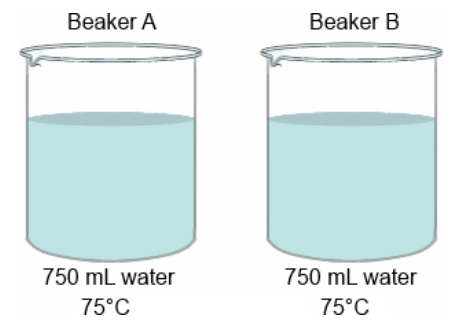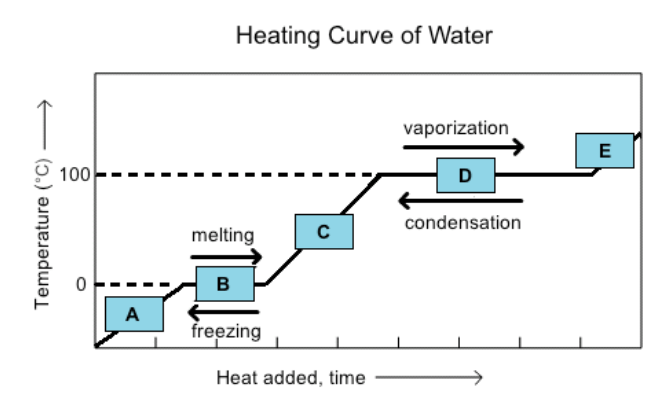This is heat transfer by direct contact.
The objects must be touching.
Conduction
What can we expect to happen to the particles in a substance when thermal energy is increased?
The particles will move faster.
When you heat water in a tea kettle, the warmer liquid rises to the surface. The cooler liquid sinks to the bottom in a cycle. What kind of heat transfer is happening?
Convection
Cindy makes herself a cup of hot chocolate on a very cold day. If Cindy's hands are very cold, and the cup is very hot, heat energy transfers from the cup to her hand because:
A. of the temperature difference between them.
B. of the size difference between them.
C. one is a solid and the other is mostly a liquid.
D. cold energy spreads from cool objects to warm objects.
A. because of the temperature difference between them.
Heat flows from warmer objects to cooler objects until they are equal temperatures.
When a liquid is heated to a gas
Evaporation
This type of heat transfer occurs in waves.
Example: The sun's heat to earth.
Radiation
When we cool down an object, what can we expect to happen to the movement of its particles?
They will slow down.
When sitting by a campfire, you are able to feel the heat from the fire to help keep you warm. What kind of heat transfer is this?
Radiation
Which of the following statements about radiation is true?
A. radiation is the only form of heat transfer experienced on earth.
B. radiation is the only form of heat transfer NOT experienced on earth.
C. radiation is the only form of heat that is unable to travel through the vacuum of space.
D. radiation is the only form of heat that can travel through the vacuum of space.
D. radiation is the only form of heat that can travel through the vacuum of space.
When liquid is cooled from a liquid to a solid
Freezing
This kind of heat transfer occurs in fluids such as gases and liquids.
Convection
Which of the following is an example of heat transfer by radiation?
A. Touching a hot stove
B. Heating a pot of water over a fire.
C. Feeling the warmth of the sun.
D. Running your hand over a hot railing outside.
C. Feeling the warmth of the sun.
In the Earth's mantle, these kinds of currents drive the movement of tectonic plates. As the liquid in the mantle heats up, it rises to the surface, then the cooler liquid sinks back to the core.
Convection Currents
Four beakers of four different sizes are filled with water to the same depth. The temperature of the water is the same in all four beakers. If 100g of ice is added to each breaker, which one will the temperature change the least?

Beaker X because it has the largest radius of all of the beakers, so it contains a largest volume of water.
When a gas is cooled to a liquid
Temperature
A spoon is placed in a cup of hot tea. Which of the following describes the heat transfer process?
A. Conduction
B. Radiation
C. Convection
A. Conduction
Heat will always move from __________ objects to _________ objects, until both reach the same temperature.
A. Warmer to Cooler
B. Cooler to Warmer
C. Larger to Smaller
D. Smaller to Larger
A. Warmer to Cooler
Two beakers of water and their starting conditions are shown below. How will the temperatures of the water in the beakers compare if an equal amount of heat is absorbed by each beaker of water?

A. Beaker A will stay the same and beaker B will increase in temperature.
B. Beaker A will increase in temperature, but beaker B will stay the same.
C. The temperature of both will decrease by the same amount.
D. The temperature of both will increase by the same amount.
D. The temperature of both will increase by the same amount.
When a solid is heated and turns liquid
The energy an object has due to the movement of its particles.
Energy from heat.
Thermal Energy
When ironing clothes, heat is transferred through direct contact between the molecules in the material. What kind of heat transfer is happening?
Conduction
What is another word for the average kinetic energy of a substance?
Temperature
Which of the following is an example of Convection?
A. Hot air rising and cool air falling.
B. A hot oven warming the air around it.
C. A hot object transferring heat to a cooler one.
D. The rays of the sun warming the earth.
A. Hot air rising and cool air falling.
The graph below is called a heating curve. It shows how water changes from one state of matter to another based on temperature and the addition or removal of heat over time. At which point on the graph would water be entirely liquid?

Point C - it is between freezing (0) and boiling (100)